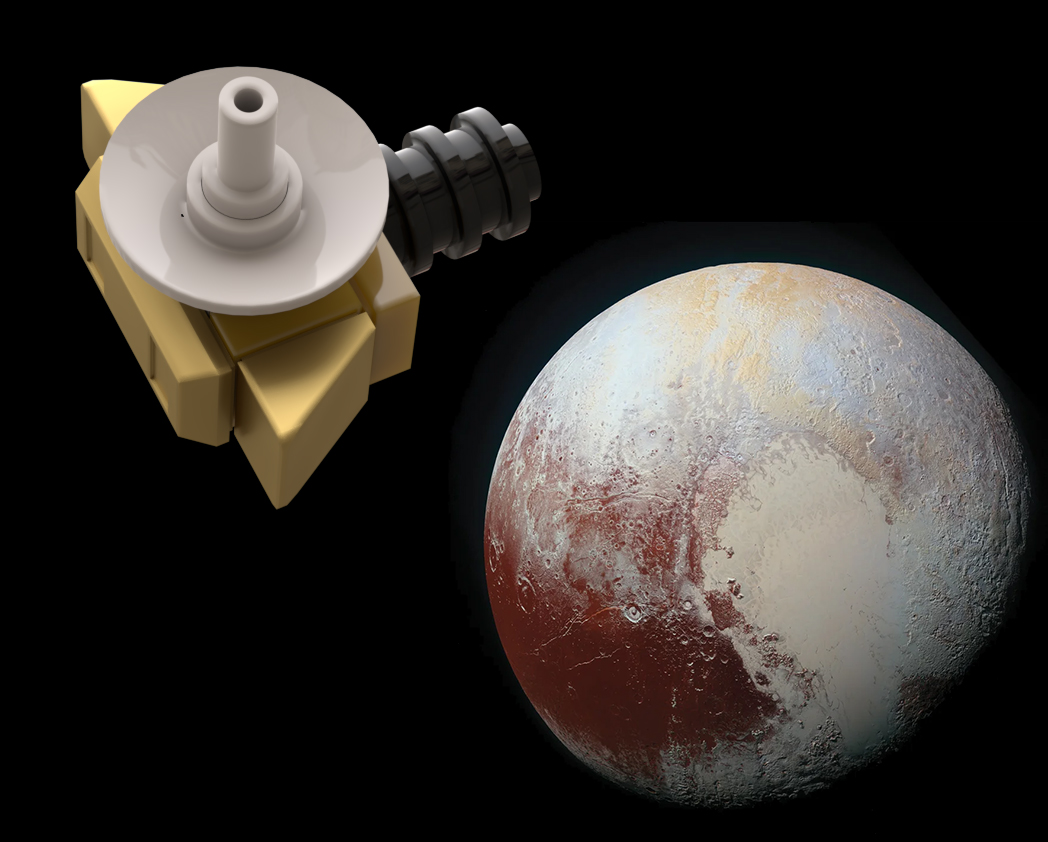
LEGO Designer:
Dan Fallon (phreaddee)
Designed:
November 2018
Categories:
Payloads, All, Outer Planets, Space Agency - NASA
Launch Vehicle Details
Stages:
Length:
Diameter:
Mass at Launch:
Low Earth Orbit Capacity:
Total Thrust:
Apogee:
Class:
New Horizons is an interplanetary space probe that was launched as a part of NASA’s New Frontiers program.Engineered by the Johns Hopkins University Applied Physics Laboratory (APL) and the Southwest Research Institute (SwRI), with a team led by S. Alan Stern, the spacecraft was launched in 2006 with the primary mission to perform a flyby study of the Pluto system in 2015, and a secondary mission to fly by and study one or more other Kuiper belt objects (KBOs) in the decade to follow, which became a mission to 486958 Arrokoth. It is the fifth space probe to achieve the escape velocity needed to leave the Solar System.
On January 19, 2006, New Horizons was launched from Cape Canaveral Air Force Station by an Atlas V rocket directly into an Earth-and-solar escape trajectory with a speed of about 16.26 km/s (10.10 mi/s; 58,500 km/h; 36,400 mph). It was the fastest man-made object ever launched from Earth. After a brief encounter with asteroid 132524 APL, New Horizons proceeded to Jupiter, making its closest approach on February 28, 2007, at a distance of 2.3 million kilometers (1.4 million miles). The Jupiter flyby provided a gravity assist that increased New Horizons’ speed; the flyby also enabled a general test of New Horizons’ scientific capabilities, returning data about the planet’s atmosphere, moons, and magnetosphere.
Most of the post-Jupiter voyage was spent in hibernation mode to preserve on-board systems, except for brief annual checkouts. On December 6, 2014, New Horizons was brought back online for the Pluto encounter, and instrument check-out began. On January 15, 2015, the spacecraft began its approach phase to Pluto.
On July 14, 2015, at 11:49 UTC, it flew 12,500 km (7,800 mi) above the surface of Pluto, making it the first spacecraft to explore the dwarf planet. In August 2016, New Horizons was reported to have traveled at speeds of more than 84,000 km/h (52,000 mph). On October 25, 2016, at 21:48 UTC, the last of the recorded data from the Pluto flyby was received from New Horizons. Having completed its flyby of Pluto,New Horizons then maneuvered for a flyby of Kuiper belt object 486958 Arrokoth (then nicknamed Ultima Thule), which occurred on January 1, 2019, when it was 43.4 AU from the Sun. In August 2018, NASA cited results by Alice on New Horizons to confirm the existence of a “hydrogen wall” at the outer edges of the Solar System. This “wall” was first detected in 1992 by the two Voyager spacecraft.
Downloads
Pay what you feel
This digital model is provided free of charge. However, if you like it, and you would like to thank the designer for their time, please consider a donation of your choice. 100% of your donation will go directly to the designer.
Donations can be made by following this link:
Part count: 13 bricks, 9 lots.
| Unit | width | length | height |
|---|---|---|---|
| Studs | 3.3 | 3.4 | 2.4 |
| Inches | 1.0 | 1.1 | 0.8 |
| Centimetres | 2.6 | 2.7 | 1.9 |
No external URL provided.
Launch History information from space.skyrocket.de
Launch History information from space.skyrocket.de
Related Posts
None found

